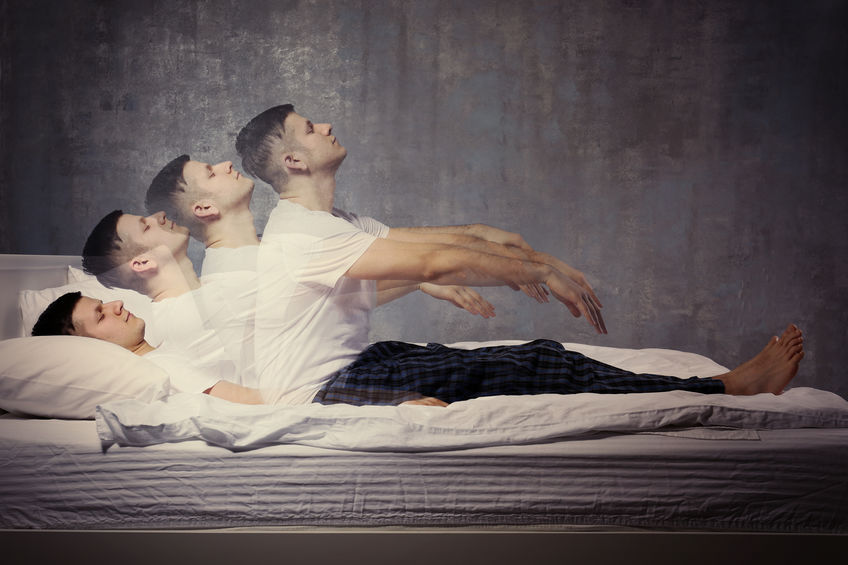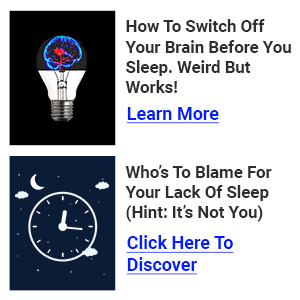Sleepwalking, a curious phenomenon that has been shown in scary movies several times. But is it really something supernatural? What does sleepwalking actually say about your health? Find out here!
Sleepwalking is a phenomenon of combined sleep and wakefulness, with patients confusing dreams with reality and acting out on it. It is similar to experiencing hallucinations, but the person is actually asleep.
This condition is also formally known as “somnambulism” or “noctambulism”.
During sleepwalking episodes, the person may move around or talk with their eyes open like a normal, wake person but they are actually still in deep sleep.
Sleepwalking is a sleep disorder classified as a parasomnia that occurs during the stages of deep sleep. When sleepwalking occurs, the affected person would barely recall the details of the episode.
Episodes may last from a few seconds up to 30 minutes, but for some cases, it can be longer than that and it can happen once a night.
But in recent observations, it shows that more and more people are stating that they are able to recall their episodes and what they were doing, but they also cannot explain how or why they cannot stop it.
The affected person enters a state of low consciousness despite being in deep sleep and perform actions that need full state of consciousness.
Aside from walking while asleep, they can also talk, sit up in bed, walk to the bathroom, clean, do regular activities, start cooking, some may even drive and some may also do violent gestures.
These actions require full consciousness, but people who are called “sleepwalkers”, can commit those actions while in deep sleep with low consciousness.
When someone is a sleepwalker, it is best to maintain safety measures such as keeping away dangerous objects or trying to watch over them during an episode, from a safe distance to avoid accidents.
Apparently, those who are sleepwalking can also end up attacking or even commit acts of homicide during an episode, making it a truly terrifying condition.
Despite this, cases of sleepwalking episodes in general are normal and repetitive activities that can be described as something simple. It is rare for an actual attack to happen, but there is a chance.
It is not known what causes sleepwalking, but there are a number of possible theories that may be accurate enough to explain the disorder.
Diagnosis
There are two subcategories for sleepwalking disorder.
- Sleepwalking with sleep-related eating
- Sleep eating involves consuming food while asleep.
These sleep eating disorders are more often than not induced for stress related reasons.
Because many sleep eaters prepare the food they consume, there are risks involving burns and such with ovens and other appliances.
Due to this, weight gain is also a common outcome of this disorder, because food that is frequently consumed contains high carbohydrates.
- Sleep eating involves consuming food while asleep.
- Sleepwalking with sleep-related sexual behavior (sexsomnia)
- A distinct form of parasomnia, or an abnormal activity that occurs while an individual is asleep.
Sexsomnia is characterized by an individual engaging in sexual acts while in non rapid eye movement (NREM) sleep.
- A distinct form of parasomnia, or an abnormal activity that occurs while an individual is asleep.
Properly diagnosing sleepwalking disorder requires a sleep study or “polysomnography”.
It is a non-invasive test where doctors will attach specific equipment on the patient’s body to monitor their overall activity. This means observing their heart, brain and body movements while the patient sleeps.
- Polysomnography (Sleep Study)
- The overall method to diagnose sleep-related conditions is called a “polysomnography” or a sleep study / sleep test, it uses all possible methods to diagnose a person’s condition
- Actigraphy
- Actigraphy is similar to polysomnography but less expensive. It is used to record the sleep and wake cycles, by analyzing the patient’s limb movements.
It is also helpful in ruling out other sleep disorders, especially circadian disorders, leading to an excess of sleepiness during the day, too.
(Related: “How to Do a Sleep Study?”)
- Actigraphy is similar to polysomnography but less expensive. It is used to record the sleep and wake cycles, by analyzing the patient’s limb movements.
- Actigraphy
- The overall method to diagnose sleep-related conditions is called a “polysomnography” or a sleep study / sleep test, it uses all possible methods to diagnose a person’s condition
However, the fact that sleepwalking episodes are not guaranteed to happen each night and it might cost a lot to keep scheduling a sleep study, reports from witnesses will help speed up the diagnosis.
In other words, if there’s anyone who saw a sleepwalker during their episodes, their reports will be helpful in conducting the diagnosis to prevent wasting time.
Diagnosing sleepwalking disorder actually has a criteria that patients must meet before they can qualify for a test. The qualifications are listed below. Once a patient is qualified, a sleep test may be scheduled.
- Recurrent episodes of interrupted sleep
- Waking, but not total wakefulness
- Experiencing intense fear
- Screaming out of panic
- Have an increased heart rate
- Profuse sweating
- Heavy breathing
- Affected person is inconsolable
- Being unable to recall their actions during an episode
- Unable to remember most parts of their dream
- The episodes is affecting the person’s quality of life
- The problem is not caused by another medical condition
- Existing medical conditions are not related to the episodes
Assessment for Sleepwalking
The way sleepwalking is assessed is similar to how other sleep disorders or parasomnias are assessed.
- When the episode occurs during sleep
- When the problem began or first observed
- How frequent the episodes occur
- How long episodes last
- How the episodes are described
- What emotions were shown
- What thoughts were present during and after the episode
- How responsive the affected person during an episode
- How conscious a person is after waking from an episode
- If the affected person remembers what happened
- What seems to trigger the problem
- What is the person’s sleeping pattern and environment
- Does the affected person experience daytime sleepiness
- Does the affected person have other sleeping disorders
- Does the affected person have a family history of sleepwalking
- If the affected person have any medical or neurological history
- If the affected person is under the influence of medication
- If the affected person has a history of addiction
Different diagnosis
There are other factors that may be confused with or should be differentiated from sleepwalking disorder.
An example of some common factors or conditions that should not be mistaken for sleepwalking disorder is when the person is under the influence of drugs or alcohols.
When a person is affected by drugs or alcohol substances, it can trigger amnesiac episodes. They may be doing certain activities that they will have no memory of the moment the drug or alcohol influence passes.
Associated disorders
There are other conditions that may be associated with sleepwalking that may be causing the problem or comes with the problem. These conditions can have a certain link that we are still trying to figure out until today.
Since the truth behind sleepwalking is still a mystery, there are many talks about it and thus, making many possibilities about it as well.
In one study called, “Sleepwalking and Sleep Terrors in Prepubertal Children”, it was revealed that when a child has another sleep disorder, there will be greater chance of having the sleepwalking disorder.
According to this study, children with chronic parasomnias may also have sleep disorder breathing or sleep disorder such as restless leg syndrome tend to have signs of sleepwalking as well.
In a later observations, the sleep disorders under the category of parasomnias begin to disappear when sleep disorder breathing and restless leg syndrome have been treated.
It is also possible that genetics may play a part in causing a sleep disorder to manifest as children with family history of sleep disorders such as sleepwalking tend to inherit the disorder later on.
Apparently, the high frequency of sleep disorder breathing among family members of children with a parasomnia serves as additional proof that sleep disorder breathing may manifest as parasomnias in children.
Most of the time, children with parasomnias are not systematically monitored during sleep.
However, past studies have suggested that patients with sleep terrors or sleepwalking have an elevated level of brief EEG arousals.
Whenever children undergo a sleep study or a polysomnography, discrete patterns are normally observed to rule out other possibilities.
Sleepwalking can also be accompanied by a related phenomenon known as “sleep terrors“, especially in children.
During a sleep terror episode, the affected person may also wander in a distressed state while still asleep similar to sleep walking disorder.
Sometimes, the affected person may also run or start behaving unnaturally aggressive as if they are defending themselves or so.
In other cases, sleepwalking disorder among adults is possibly a symptom of psychological disorders.
According to studies, adult sleepwalkers also tend to have records of schizophrenia, hysteria and anxiety neuroses.
Sometimes, a headache can also trigger a sleepwalking episode. Apparently, patients with migraine headaches or Tourette syndrome are four to six times more likely to have a sleep walking episode.
Symptoms
In reality, noticing the symptoms of sleepwalking may actually be difficult especially during the first few encounters. This is because the person who is sleepwalking will appear fully awake and confuse witnesses.
Apparently, there are specific symptoms that characterizes sleepwalking that can avoid confusion. Here’s a list of common symptoms that may help confirm sleepwalking.
- Partial arousal during non-rapid eye movement sleep
- Having a dream that may or may not be recalled when they wake
- Signs of acting out a dream
- Doing regular activities but not responsive to other people
- Screaming, crying or other vocalization
- Common physical reactions during a dream
- Difficulty perceiving their environment
- Impaired judgement or problem-solving
- Dilated pupils with blank stares
- Acting confused when interrupted during an episode
- Talking without proper sense
- Forgetting why they’re not in bed
- Not knowing where they are after waking
- Being slightly or moderately amnesiac
- Confusing reality with the dream from their sleep
Please keep in mind that experiencing one or more of the following symptoms does not automatically confirm your condition.
It is still important to undergo an actual physical examination with your doctor for better diagnosis.
Waking during a sleepwalking episode
When an affected person completely wakes up during a sleep walking episode, there’s a tendency of exhibiting violent behavior due to extreme confusion.
It’s common for sleepwalkers to lash out at the person that wakes them, or vent their confusion, emotions or such to the first object they can see and will be followed by a breakdown or screaming.
There are times when an awakened person may stare silently for seconds as their confused reaction and attempt to understand the situation, but there’s still a chance that they may attack whoever is near them.
This is why some people may not know what to do if a person they know is having a sleepwalking episode.
It is best to stay close to them to keep them away from danger and only wake them if it’s necessary. Otherwise, it is the person who wakes the affected patient that may be in danger.
The best option is to call for help or assistance to hold down a person affected by sleepwalking disorder.
Causes
Until today, the true cause of sleepwalking is still unknown. But of course, there are plenty of theories that can possibly be correct. Here are some of those hypotheses.
- Delayed maturity of the central nervous system
- Increased slow wave sleep (deep sleep)
- Lack of sleep (sleep deprivation)
- Having a fever
- Excessive tiredness (fatigue)
- Genetics (hereditary)
- Having a migraine or Tourette Syndrome
- A problem with serotonin levels
- Hormonal fluctuations
- Using certain medications
- Parkinson’s disease
Keep in mind that those in this list are just possibilities and none have been confirmed so far which is why there are still many people who would rather link sleepwalking with “supernatural” theories for now.
Treatment
After a long time of trying to find a cure, many experts revealed that no amount of psychological or medical treatment have made any positive results in treating sleep walking disorder just yet.
They’ve tried many things which will be listed below.
- Psychoanalysis
- Hypnosis
- Assertion training
- Relaxation training
- Anger management
- Improved sleep hygiene
- Classical conditioning
- Play therapy
- Anticholinergic (biperiden)
- Antiepileptics (carbamazepine, valproate)
- Antipsychotic (quetiapine)
- Benzodiazepines (clonazepam, diazepam)
- Melatonin
- Selective serotonin reuptake inhibitor
- Barbiturate
- Herbs
Even after all these trials, none has been proven to heavily affect sleepwalking. It may help improve the symptoms or its aftermath, but no direct cure for the condition itself has been found.
In that case, people who are taking care of sleep walkers or are sleep walkers can make use of the following tips below.
- Tips on How to Deal with Sleep Walkers
- Avoid waking the patient during an episode unless necessary
- Comfort the affected person after an episode
- Remove or keep away dangerous items, objects
- Follow a healthy sleep routine
- Some people consider hypnosis
- Manage stress
- Treat other conditions that may worsen sleep walking
- Psychotherapy
- Counseling
Even though there is no evidence whether it is harmful to wake a sleepwalker during an episode or not, it is still best to avoid waking them as they can react violently without warning.
- Lifestyle Changes tips that can improve Sleepwalking
- Follow a proper, healthy sleep schedule
- Sleep on time and avoid depriving yourself with sleep.
- Try to get plenty of exercises
- Keeping your body awake and properly energized can improve your overall health. But remember not to exercise too much and exercise only in the morning.
- Eat a healthy, balanced diet
- Your diet plays a role in improving the quality of your sleep.
- Avoid alcohol before sleep
- Alcohol can cause your body to become dysfunctional.
- Stop unnecessary drug usage
- When under the influence of drugs, a person’s body may become dysfunctional
- Treat other illnesses (mental illnesses)
- Focusing on your anxiety, depression and other mental health issues can help stop the symptoms of sleepwalking disorder.
Your mental health is important and affects your overall physical wellness.
- Focusing on your anxiety, depression and other mental health issues can help stop the symptoms of sleepwalking disorder.
- Do some therapeutic activities
- Relaxing before bed can also take your mind off your worries and help you sleep better.
- Manage your stress
- Stress, regardless if it’s physical or mental, can cause your brain to become less effective and lead to other problems and sleepwalking is one of them.
- Avoid sleeping with a heavy stomach
- Going to bed with a heavy stomach can create difficulty in breathing, it may disrupt the system inside your body and also trigger sleeping problems.
- Try to improve your surrounding environment
- Your surroundings can affect you, mentally, or physically. Even your bedroom can boost your mental health.
If possible, consider improving your lifestyle and surroundings.
- Your surroundings can affect you, mentally, or physically. Even your bedroom can boost your mental health.
- Follow a proper, healthy sleep schedule
Even if it may not help directly, it can improve one’s overall health. Doing so can potentially stop the risk of sleepwalking episodes too.
Risks
- Poor quality of sleep
- Restless nights
- Affecting relationships
- Getting into accidents
- Life-threatening accidents
- Triggering depression, anxiety
- Potentially worsen other sleep conditions
- Committing violence unconsciously
Apart from the poor quality of sleep, the main risks that sleepwalking episodes can actually possess is the risks of getting into accidents during a sleepwalking episode.
It may also affect a person’s lifestyle or the people around them, but overall, it does not harm the physical health but can trigger anxiety or depression for those why may be worrying about it.
It is rare for a person or a sleepwalker to attack someone or completely hurt someone, but there is still a possibility.
Another rare case is when sleepwalkers have fractured bones and died as the result of their fall. Sleepwalkers may also face embarrassment of being found clueless in public after waking from an episode.
Related Questions
Has a sleepwalker ever killed someone?
Yes, there have been cases of homicide where the prime suspect was actually having a sleepwalking episode.
What happens when you wake up a sleepwalker?
Waking up a sleepwalker may cause them to suddenly attack the person who woke them or cause them to fall into a state of confusion.
Their physical health will not be harmed, but their emotional state can be affected.
How can you tell if someone is sleepwalking?
You can tell if someone is sleepwalking much easier if you witnessed the beginning of an episode. For example, you saw them get out of bed all of a sudden and start walking around with a glazed, glassy-eyed expression.
They may also not respond to any form of communication, pertaining that they cannot see you or hear you. Even when they talk, their words commonly do not make sense to witnesses.
If you start waking them up, it may seem like a struggle and they’re not responding to your attempts of waking them. Once they awaken, they may act confused or lash out on you.
These are signs that can help you tell if someone is sleepwalking or not.




